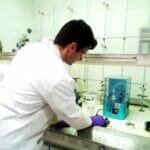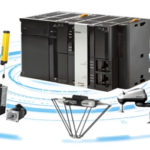Since the full impact of the COVID-19 pandemic hit home in the early part of 2020, many companies within the Medical, Pharmaceutical and Life Sciences sectors have been working flat out: undertaking essential research into a possible vaccine, providing essential analytical and testing resources and of course manufacturing PPE.
As for any other sector where demand increases, and particularly where tasks are repetitive, require validation, traceability, and are undertaken within strict environmental conditions, the introduction of robots delivers the consistent quality and productivity improvements needed to support the increase in demand. Although the pandemic has had a negative effect on investment in many sectors, recent figures from the Robotics Industry Association show that sales of Robots to the Lifesciences, Pharmaceutical and Bio-Med sectors, between January and June 2020 were up by 97% when compared to the same period in 2019.
This article by Stäubli’s Simon Jenkins highlights just one of the areas where robots are now playing an increasingly important role in supporting new and important production processes.
Whilst the Medical, Pharmaceutical and Life Sciences sectors do not have the same number of robots operating within manufacturing roles as the automotive industry, the applications they undertake are often highly sophisticated and performed under stringent regulatory and environmental conditions.
Within these essential sectors, robots are able to operate in environments which are unsuitable or even dangerous for humans, especially if there are bio-hazards, toxic or radioactive materials involved. In areas where cleanliness is essential, robots eliminated the potential risks from human contamination, and of course in every application, the speed, repeatability and reliability of robots are valuable attributes.
Over the years, Stäubli has established an enviable reputation within these sectors through a combination of its technical expertise, performance of its robots and familiarisation with the stringent regulatory requirements surrounding the industry. Today, Stäubli robots can be found operating at all levels, whether in handling primary packaging such as syringes and infusion bags or secondary packaging such as folding boxes and cartons.

(The Stäubli robots in this facility processes hip bone into cube-shaped bone replacement tissue for use in several orthopaedic procedures)
Simon Jenkins explains: “Our many years of collaboration with machine manufacturers and OEMs within these sectors has enabled us to build up application expertise and regulatory knowledge across many different products and production processes. The life-sciences sector is a great example of how robots can make a valuable contribution, not just to the specific manufacturing to processes themselves, but by making it possible to deliver products which will ultimately enhance the well-being of individuals. An excellent example of this is the system used by Belgium start-up company Texere Biotech, to process bone material into implants.”
This unique and fully automated system uses femoral heads (i.e. the top end of the human thigh bone) and processes them into cuboid implants known as “bone allografts”. Six Stericlean robots supplied by Stäubli handle this bone replacement tissue under cleanroom conditions. Allografts are in high demand, because natural bone is the best material for bone transplants. Its micro-porosity ensures that it engrafts well whilst at the same time, the patient is spared the painful removal of autologous bone. The plant has the capacity to process 5,000 femoral heads a year. Because these are meticulously measured and optimally segmented, each produces an average of six blocks.
Six identical TX60 Stericlean robots are positioned at separate stations along the processing line. The first lifts one whole femoral head from a tray and transfers it to an image processor which assesses it for size and shape. This data is used to map out the cutting lines for the next stage in which the second robot presents the bone tissue to the fully encapsulated water jet cutting machine. Robot number three retrieves the resulting cuboid allografts and places them on a tray. The next two robots in line are responsible for handling the allografts as they undergo chemical treatment and sterilization. At station number six, the last of the Stericlean robots inserts the individual cubes in vials.
In addition to increased efficiency in the processing of femoral heads, the other main advantages brought about by full automation are the traceability of each bone allograft block, the reliable removal of virus transmission and of the elimination of the cross-contamination risks between the bone tissues from the different donors.
Simon Jenkins continues: “For this demanding application, Stäubli’s Stericlean range proved to be the best solution, influenced by the unsurpassed hygiene standards of the robots and the numerous references from satisfied customers in the medical technology sector, including operating theatres. The robots are fully functional in VHP
(vaporised hydrogen peroxide) environments and are compliant with the strict GMP (good manufacturing practice) guidelines. The robots not only stand out by virtue of their cleanroom compatibility but also in terms of dynamics, precision and reliability.”
Stäubli robots are actively involved with multiple life-sciences applications such as cell screening, IV bag manufacturing / filling, pharmaceutical product inspection and the filling / assembly of syringes. In each case, robots of many different configurations are at the heart of these manufacturing processes.








